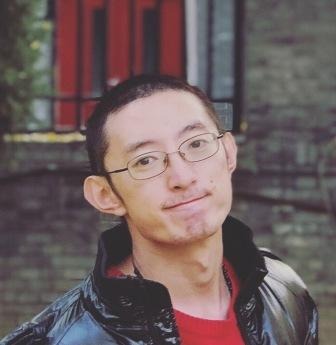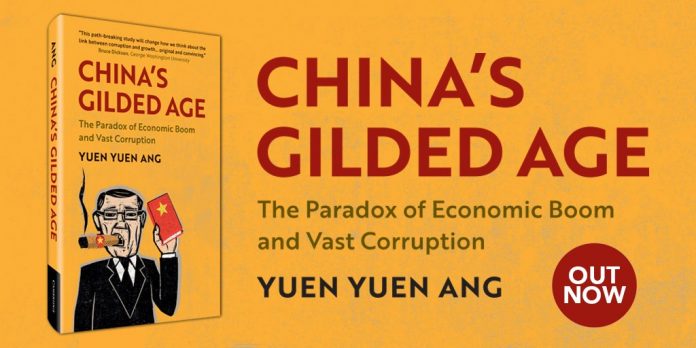A Review of China’s Gilded Age: The Paradox of Economic Boom and Vast Corruption by Yuen Yuen Ang
The Chinese authoritarian regime appears so exceptional that it defies scholarly claims and conventional wisdoms on nearly every front. As early as 1990s, the western scholars have been expecting or forecasting the regime collapse or democratic transition by invoking the modernization theory that economic development, coupled with swelling affluent and well-educated middle class, would propel China towards a more inclusive and democratic society. Nonetheless, the authoritarian system remains strong and resilient as the longest surviving communist regime. Likewise, it’s commonly believed that corruption is detrimental to economic growth, but China is an outlier again. While corruption has been rampant to the extent that it may, according to Chinese President Xi Jinping, “doom the party and the nation”, China has always been one of the fastest growing economies since the policy of “reform and opening up” was inaugurated in 1978. This paradox prompted the author to demystify how and why vast corruption in bureaucracy goes hand in hand with fast economic expansion.
In literature review part, the author revisits four representative theories on China’s corruption: first, Chinese regime is forecast to collapse due to corruption; second, China’s economic growth is so fast that corruption could not hurt; third, the intensive anti-graft campaigns play a role in bringing corruption under control; fourth, China’s corruption is “less destructive” in comparison to corruption in other countries. Yet, as is contended by the author, the paradox remains unaddressed despite the existing scholarship. Based on exchange/theft dimension and elites/non-elites dimension (P. 8), the author innovatively “unbundled” the concept of corruption by dividing it into different types: petty theft (stealing and misuse of public funds or extortion among grass-root bureaucrats), grand theft (embezzlement or misappropriation of large amount of public funds by political elites), speed money (petty bribes paid to bureaucrats to expedite things) and access money (rewards offered by businesses to powerful officials not only for expedition but also for exclusive access and privilege) (P. 10).
It is the unbundled conceptualization of corruption that facilitates the author to address the paradox of why corruption doesn’t hurt China’s prosperity. According to the author’s explanation, access money, as the dominant type of corruption in China, facilitates private investment, or even over-investment, and thus promotes economic growth (P. 14) while her empirical data show that other types of corruption such as speed money and petty/grand theft were declining due to state-building efforts in 2000s (P. 18). From institutionalist angle, Ang argues that China’s political system ensures local officials compete with one another by linking local officials’ career prospect with indicators of economic performance. Meanwhile, from rationalist angle, it’s explained that local officials are strongly-motivated to stimulate local economic growth as they benefit from it politically (career promotion) and financially (taking bribes as rewards) (P. 15-16).
Although these efforts are designed to solve the paradox of China’s bureaucratic corruption and economic expansion, they touch little upon the “exceptionalism” question: Is China exceptional in terms of this phenomenon? The author’s answer is “No” as she compares and contrasts the reform era of contemporary China with the Gilded Age of America in the 19th century based on comparative-historical data and media report on corruption.
The highlight of this study comes in at the Chapter Six on the anti-corruption campaign presided by Chinese President Xi Jinping after his ascendance to the paramount leadership. Based on her proposition that access money stimulates economic growth, the author raises further question: Does prolonged anti-corruption campaign hurt growth? To approach this question, the author first assesses what leads to downfall of officials. Ang conducts quantitative analysis of the downfall (defined as being investigated) of city-level party secretaries during the campaign. The analysis covers a group of 331 city party chiefs, examines the share of the city’s GDP growth in provincial GDP growth as a measure of performance (P. 163) and their patron-client relationship with party chiefs at higher level (provincial party chiefs, political standing committee members and Politburo members) (P. 164-165) to investigate whether the downfall of some of the city party secretaries is more likely to be caused by the downfall of their patrons (defined as those higher level party members who appointed the city party secretaries). The author concludes that the downfall of the patron is likely to have stronger effect on the downfall of city leaders than delivered local economic performance and media profile; and having patrons at Politburo or Political Standing Committee doesn’t necessarily preclude the downfall of the clients at city level (P. 173). In addition, the research also reviews the patron-client relationship of fallen former province-level Chongqing party secretary Sun Zhengcai as the patron and his political outcomes of his clients and found that the downfall of Sun doesn’t necessarily predict the downfall of his city-level clients, so that the author cautiously argue that these results do not verify the prevalent argument that the anti-corruption campaign is used as a tool for Xi Jinping to purge political rivals (P. 173). Then the author used descriptive language to discuss whether and how anti-corruption may hurt growth.
The book has multiple folds of contributions to academia. First, conceptual unbundling and innovative typology. While previous corruption studies treated corruption as unitary and collective concept, Ang’s research “unbundles” this concept and classifies corruption into sub-types, which captures both elite/non-elite types and transactional/non-transactional types of corruption and helps challenge the conventional wisdom all corruptions are the same and all types of corruptions are harming economic growth. Second, expanded research scope. Although the study focuses on the relations between Chinese-style corruption and economic expansion, it goes beyond “corruption” itself by expanding the discussion into “anti-corruption” campaign which is the on the frontier of scholarship in recent years, and its impact on China’s economic growth and future development. Third, cross-national comparison. The author offers a comparative perspective to ascertain the similarities and differences between two Gilded Ages by drawing upon media-reported corruption cases in China’s reform era from 1999 to 2016 and America’s gilded age from 1870s to 1940s, which suggests China is not exceptional and unprecedented in the phenomenon of corruption advancing with economic expansion because the economic development of democratic countries with sound institutions experienced this process too (P. 193). Nonetheless, the author highlights the differences between China’s elite corruption (as a form of personal incentives of officials) and America’s institutional corruption (as a form of political participation and representation) (P.193).
Despite these contributions, this research is not without shortcomings.
First of all, to evaluate whether the anti-corruption campaign hurts China’s economic growth, Ang cited news outlet and previous scholarship to explain the short-term effect of dampening economy and long-term effect of making a healthier economy (P. 175). But the problem is that the cited scholarship assumes corruption is a “bundled” concept that the author challenges from the very beginning of this study. Therefore, the author has to first specify that the anti-corruption campaign is intended to crack down growth-stimulating “speed money”, one of the four subtypes of “unbundled” corruption, to further elaborate that this type of corruption may dampen growth.
Second, in assessing which factors are more likely to cause the downfall of the city party-chiefs, the author evaluates the patron-client relationship between city-level party chiefs and those who appointed them to the current position to draw the conclusion that the fall of patrons, as opposed to economic performance and media profile, is more likely to cause the fall of the clients. This argument is sound but incomplete because only focusing on the lower level city party chiefs alone doesn’t provide a full picture of the anti-corruption campaign. To evaluate the factors that account for the downfall of the city-level party secretaries (the clients), the author has to ascertain which factors are more likely to account for the downfall of the patrons (provincial party secretaries, or higher Politburo members) in the first place. Besides, the author ignores an alternative possibility that it’s the downfall of the clients that may cause the downfall of the patrons, which also deserves investigation.
Third, according to the author, the research doesn’t support the “political warfare” theory that the crackdown on corruption is a tool for President Xi Jinping to purge his rivals, which is, of course, sound and valid, but hasty. But the author stops short of explaining why it doesn’t verify the “political purge” argument. The reason should be that the analysis is not intended to prove or disprove this theory. Without evaluating whether the clients of President Xi Jinping have been promoted, transferred or investigated during the anti-corruption campaign, this analysis alone is far from sufficient to support this “political warfare” argument.
Fourth, in discussing the America’s Gilded Era and the following Progressive Era, the author applies this concept to the Chinese context to assert that China has been in Progressive Era since 2012 when Xi took office (P. 188). We understand that such analogy is drawn solely based on anti-corruption campaign and social reforms in both countries. However, it’s flawed as this analogy doesn’t capture the different anti-corruption approaches in America and in China, respectively. As is explained by the author, Xi cuts off society’s role in monitoring corruption and adopts a top-down approach to clamp down corruption, which distinguishes China’s anti-corruption path from American Progressive Era (P. 210), so this analogy is inappropriate.
Overall, the author is successful and innovative in addressing a wide range of corruption-related questions: definition of corruption, the measurement of corruption, impact of corruption on economic growth, effect of corruption on inequality, and anti-corruption approaches in authoritarian China. However, the author raises some questions for discussion that need to be further studied with empirical analysis. First, does anti-corruption campaign serve as an instrument for President Xi to purge rivals and consolidate power and how? Second, does the crackdown on “access money” plays a role in decelerating economic growth and how?

Keyu Chen served as financial translator for Goldman Sachs, J.P. Morgan and Deutsche Bank. He holds M.A. in international journalism and communication from Beijing Foreign Studies University. He’s interested in political communication, comparative politics and international relations.


